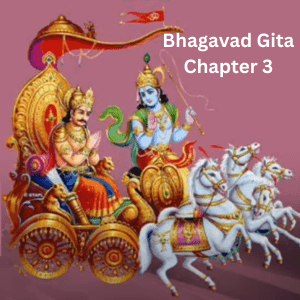Table of Contents
ToggleUnderstanding the Teachings of Bhagavad Gita Chapter 3: Karma Yoga and Selfless Action

The Bhagavad Gita, a cornerstone of Hinduism, resonates with profound wisdom on various aspects of life. Chapter 3, titled Karma Yoga (The Yoga of Action), delves into the concept of selfless action, offering a roadmap to navigate the complexities of duty, desire, and liberation. This blog dives deep into all 43 verses of Chapter 3, unveiling the key learnings for a fulfilling and spiritually-evolving life.
Overview of Bhagavad Gita Chapter 3
Arjuna’s Dilemma: Inaction vs. Rash Action (Verses 1-2)
The chapter opens with Arjuna, the mighty warrior, beset by a moral crisis. Torn between his duty to fight and the potential bloodshed, he contemplates inaction. Krishna, his divine charioteer and embodiment of the divine, addresses his concerns.
The Flawedness of Inaction (Verses 3-5)
Krishna emphasizes that inaction is not an option. Even the body’s basic functions necessitate action. Inaction out of fear or delusion leads to stagnation and hinders growth.
The Importance of Performing Your Duty (Verses 6-8)
The chapter introduces the concept of Swadharma – one’s inherent duty based on their nature and position in society. Fulfilling one’s Swadharma is not just about work, but acting with a sense of responsibility for the greater good.
The Delusion of Doership (Verses 9-15)
Krishna clarifies that the true Self (Atman) is beyond action and its fruits. The body, mind, and intellect are the instruments of action, not the doer itself. Detachment from the fruits of action leads to liberation.
Offering Through Yajna (Verses 10-16)
The concept of Yajna (sacrifice) is introduced. Yajna is not just about fire rituals, but offering one’s actions to the divine. By dedicating our work to a higher purpose, we transcend self-interest and purify our actions.
The Peril of Attachment (Verses 17-25)
The chapter warns against attachment to the fruits of action. Craving specific outcomes leads to suffering. Performing our duty with equanimity, accepting both success and failure, brings peace and inner freedom.
The Wise Live in Action (Verses 26-29)
These verses discusse the distinction between Sankhya Yoga, the path of knowledge, and Karma Yoga, the path of selfless action. Those who understand the Self remain active in the world while being detached from results. They set an example of selfless service and inspire others.
The Control of the Senses (Verses 30-35)
The uncontrolled senses can lead us astray. Mastering the senses through self-discipline is crucial for performing our duties righteously.
The Nature of Lust and Anger (Verses 36-41)
Lust and anger, born from the mind’s attachment, are powerful obstacles. Recognizing their destructive nature is the first step towards taming them.
The Hierarchy of Being (Verses 42-43)
The chapter concludes by outlining the hierarchy of being – the senses, the mind, the intellect, and finally the Atman, the true Self. By aligning ourselves with the Atman, we find true liberation.
Key Learnings from Chapter 3
- Karma Yoga: It advocates performing actions without selfish desires or attachments to the results.
- Swadharma: Fulfilling one’s inherent duty based on their nature and role in society.
- Detachment: Letting go of attachment to the fruits of action and accepting both success and failure.
- Yajna: Offering our actions to a higher purpose, a form of selfless service.
- Self-Discipline: Mastering the senses and the mind to perform our duties righteously.
- Atman: The true Self, the unchanging essence beyond action and desire.
Living Karma Yoga in Everyday Life
The principles of Karma Yoga are applicable to everyone, regardless of their profession or background. Here’s how to integrate them:
- Identify your Swadharma: Reflect on your skills, values, and position in society. What is your unique contribution?
- Focus on the process, not the outcome: Immerse yourself in the present moment and enjoy the act of doing.

- Develop equanimity: Accept that success and failure are part of life. Learn from both experiences.
- Practice self-discipline: Manage your emotions and impulses to act with clarity and purpose.
- Serve with a grateful heart: Offer your skills and resources for the betterment of others.
Bhagavad Gita Chapter 3 and its Relevance in the Modern World
The wisdom of Chapter 3 transcends time and culture. In today’s fast-paced world, overwhelmed by information and competition, this chapter offers an anchor. Here’s how it can be relevant:
- Combating Stress and Anxiety: By focusing on the present moment and letting go of attachment to outcomes, we can find peace amidst chaos.
- Finding Purpose: Identifying your Swadharma and contributing your skills to a larger cause brings a sense of fulfillment that material success alone cannot offer.
- Building Healthy Relationships: When we act with selflessness and service, our relationships become stronger and more meaningful.
- Environmental Sustainability: Yajna can be interpreted as caring for the environment, considering it an offering to a higher power.
Conclusion
Bhagavad Gita Chapter 3 offers a timeless guide for navigating life’s challenges. By embracing Karma Yoga, we can lead a life of purpose, fulfillment, and inner peace. It reminds us that action is inevitable, but our attitude matters. By aligning our actions with higher principles and selflessly serving others, we can attain spiritual growth and inner peace. By delving deeper into the Bhagavad Gita, Chapter 3, we embark on a journey of self-discovery and liberation. It’s a path that empowers us to navigate life’s complexities with purpose, peace, and a sense of connection to the divine.
Remember, the essence lies not only in reading but also in living these teachings. May your journey toward self-realization be filled with wisdom and compassion!
Frequently Asked Questions
Q: What is the Bhagavad Gita?
A: The Bhagavad Gita is a sacred Hindu scripture that contains spiritual teachings imparted by Lord Krishna to Prince Arjuna on the battlefield of Kurukshetra.
Q: Why is Chapter 3 significant?
A: Chapter 3 of the Bhagavad Gita expounds the concept of Karma Yoga, emphasizing the importance of performing actions selflessly and without attachment to their results.
Q: How can one practice Karma Yoga?
A: Karma Yoga can be practiced by performing actions with selflessness, dedicating them to the divine, and renouncing attachment to the fruits of actions.
Q: What is the concept of duty according to the Bhagavad Gita?
A: According to the Bhagavad Gita, duty (dharma) refers to one’s righteous responsibilities in life, which should be fulfilled without attachment to personal gain or desire.
Q: How can the teachings of the Bhagavad Gita help in daily life?
A: The teachings of the Bhagavad Gita provide guidance on leading a righteous and fulfilling life, fostering inner peace, and achieving spiritual growth.
